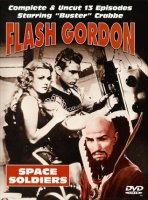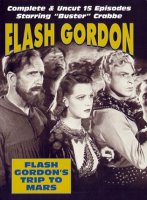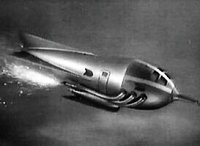
Flash Gordon's most successful foray into other media was, of course, the 1936 serial Flash Gordon
(AKA Space Soldiers). Starring Buster Crabbe with a blond dye-job as Flash, Jean Rogers as a sexy
Dale Arden, Frank Shannon as a somewhat stodgy Dr. Zarkov, Priscilla Lawson as a sultry Princess
Aura, Richard Alexander as a pudgy Prince Barin, Jack "Tiny" Lipson as an amusing and easily amused
King Vultan, and the excellent Charles Middleton as Ming the Merciless, this first Flash Gordon
serial produced by Universal Pictures was remarkably faithful to Alex Raymond's storyline, with the

set design of some scenes apparently taken straight from Raymond's comic strip panels. While the
cheap sets, primitive special effects, and stilted dialogue can cause unwanted chuckles among
today's audiences, this serial is a rousing, non-stop actioner that continues to influence
filmmakers, most notably George Lucas in his Star Wars series. Despite its limitations, or perhaps
because of them, Flash Gordon is the epitome of Space Opera in the grand tradition and remains
great fun to watch.

Given the immense popularity of the first serial, it isn't surprising that Universal Pictures
rushed out with another one in 1938. Although taking plot elements and characters from Alex Raymond's
strip, Flash Gordon's Trip to Mars made some significant deviations from the comic strip canon -- most
notably transferring the action to Mars, reportedly to capitalize on the interest in Mars that was
generated by Orson Welles's radio broadcast of The War of the Worlds, and the addition of Happy
Hapgood, an annoying journalist unnecessarily added to Flash's crew for comic relief. The plot this
time has Ming the Merciless visiting Azura, the Queen of Magic on Mars (Witch Queen of the Blue Magic
Men on Mongo in the original comic strip), and colluding with her to focus a deadly ray on the Earth
so that he can wreak his revenge for the problems caused by Flash in the first serial. Flash, a

disappointingly brunette Dale, and Dr. Zarkov, joined by the hapless Happy Hapgood, suspect that the
attack is coming from Mongo, and blast off in their rocketship to thwart Ming's evil plans -- but
discover enroute that the ray is really coming from Mars and adjust their trajectory to land on the
Red Planet. Since the detour to Mars was obviously done for commercial reasons, the scriptwriters
had to strain a bit to incorporate Alex Raymond's Mongo - bound storyline, and it's a bit of a
surprise when part way through the serial Prince Barin of Arboria shows up for no convincing reason.

Although the sets are a bit cheaper, and some of the special effects shots have obviously been
salvaged from the first serial, the acting is generally better than in 1936's Flash Gordon, and all
of the main characters are played by the same actors (Jean Rogers had reportedly dyed her hair brown
for another film she was making at the same time), with the addition of Beatrice Roberts as Queen
Azura and Donald Kerr as Happy Hapgood. It's not as fresh or as exciting as the first serial, but
Flash Gordon's Trip to Mars is still great fun, and is actually preferred by some fans.

The final Flash Gordon serial, Flash Gordon Conquers the Universe, was released by Universal
Pictures in 1940. Back on Mongo this time, Ming the Merciless has been busily sending spaceships
to Earth to poison the atmosphere with dust that causes the Purple Death. So Flash, Dale (this
time played by Carol Hughes -- who more closely resembles the Dale of the comic strips -- but who is no
match for Jean Rogers, whether blonde or brunette), and Dr. Zarkov must return to Mongo to once
again thwart Ming's nefarious plans. On Mongo, they meet up with old friends Prince Barin and
Princess Aura, now married and played by different actors, and enlist the aid of Queen Fria of
Frigia to fight Ming, the treacherous Sonja, and the villianous Captain Torch to once again save
the Earth. Although the storyline returns to Alex Raymond's source material (with the exception of
the aforementioned "Purple Death"), the actors are getting tired and the use of stock footage
increases. The costumes are beautiful, however, and this concluding installment in the trilogy has
its supporters.










